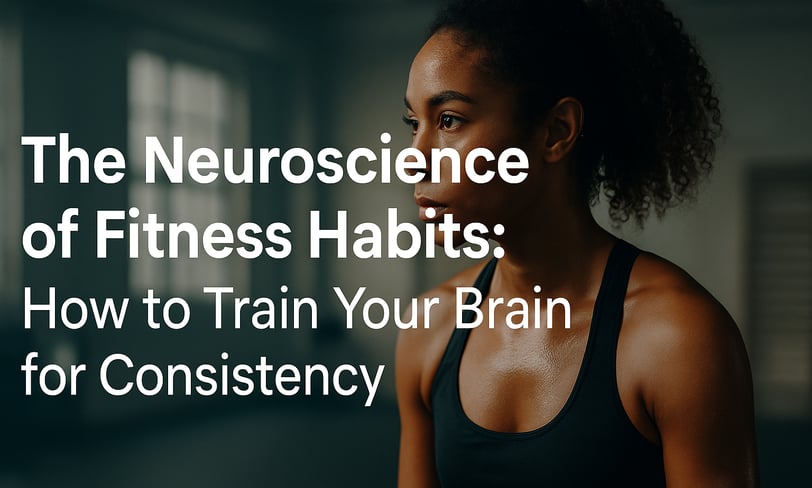The Neuroscience of Fitness Habits: How to Train Your Brain for Consistency
Discover how your brain forms fitness habits and what it really takes to stay consistent long-term. Backed by neuroscience, this article breaks down habit loops, neuroplasticity, and the top tools to lock in your workout routine for good.
5/31/20253 min read


The Neuroscience Behind Habit Formation in Fitness
Why do some people stick to their workouts like clockwork while others fall off within weeks? The answer isn’t just about willpower — it’s about how our brains form and reinforce habits. Understanding the neuroscience behind habit formation can completely change the way you approach fitness.
What Happens in the Brain When You Form a Habit?
At the center of it all is the habit loop: cue, routine, and reward. A cue triggers the behavior, the routine is the workout itself, and the reward helps lock it in. Over time, your brain begins to anticipate the reward, and the action becomes automatic.
But underneath the surface, there’s something even more powerful happening: neuroplasticity. This is the brain’s ability to adapt, rewire, and reinforce new neural pathways as behaviors repeat. Every time you work out consistently, your brain gets better at recognizing that action as “normal,” building a subconscious association between your cue and your routine.
Regular movement also boosts brain-derived neurotrophic factor (BDNF), which helps support new neuron growth and strengthens neural connections — making it easier to learn new behaviors and maintain them.
How Long Does It Actually Take?
You’ve probably heard that it takes 21 days to form a habit. But research out of University College London shows it’s more like 66 days on average, and it can take up to 254 days depending on the complexity of the habit and the individual. The key? Consistency, not perfection.
Start Small, Stay Consistent
One of the best strategies for building lasting fitness habits is to make the barrier to entry so low that it's hard to say no. If your plan requires 60 minutes and a full gym setup, it’s easy to skip. But if you start with a 10-minute at-home workout, it becomes far easier to stay consistent.
Product we recommend: Habit Nest Dumbbell Workout Cards
What it is: A full deck of guided dumbbell workouts that you can do anywhere, anytime .
Why it works: Reduces decision fatigue by giving you a structured plan right out of the box.
Key benefits:
– Easy-to-follow strength circuits
– Great for building consistency
– Compact and travel-friendly
Best for: Beginners or busy individuals trying to create a home routine.
Keep this deck by your desk or nightstand to remove the biggest obstacle to habit-building — figuring out what to do.
Use Cues and Rewards Strategically
Your brain thrives on associations. Try linking your workouts to something that already happens regularly — like brushing your teeth, starting work, or ending your day. That way, the cue is built into your life.
And don’t skip the reward. That might be a smoothie, a 10-minute chill session, or just crossing off your workout on a whiteboard. Rewards don’t have to be big — they just need to make your brain go, “Yep, that was worth it.”
Product we recommend: Grenade Carb Killa Protein Bars (Salted Caramel)
What it is: A delicious, high-protein bar to support recovery after your workout Amazon.
Why it works: Reinforces the reward loop and helps rebuild muscle with 20g of protein.
Key benefits:
– Tastes great, no chalky texture
– Low sugar, high protein
– Great grab-and-go option
Best for: Post-workout recovery or a late afternoon snack that doesn’t ruin your macros.
Stack a box in your gym bag or pantry so that every time you finish a workout, you’ve got a small win waiting.
Track It to Reinforce It
Once your routine starts to form, tracking your behavior can create a feedback loop that strengthens the habit. When you see the data, your motivation increases.
This is where wearable technology shines. Devices that monitor sleep, stress, recovery, and readiness can help you better understand how your body is adapting to your fitness lifestyle — and keep you on track even when motivation fades.
Product we recommend:RingConn Gen 3
What it is: A sleek, smart ring that tracks sleep, heart rate, activity, and recovery Amazon.
Why it works: Gives you biometric data on how your fitness and lifestyle habits are impacting your health.
Key benefits:
– In-depth sleep and readiness tracking
– Long battery life and subtle design
– Tracks trends without overwhelming you
Best for: Anyone serious about optimizing recovery and staying accountable.
Wear it 24/7 to get an inside look at how your body is responding to your new fitness habits.
Final Take
Habit formation isn’t just about “trying harder” — it’s about working with your brain, not against it. By setting up clear cues, manageable routines, and small but satisfying rewards, you lay down the neural groundwork for lasting change. Track your wins, stay consistent (even if it’s not perfect), and over time, those actions become automatic.
The science backs it: building fitness habits is possible for anyone — but it takes structure, strategy, and patience. And the right tools can make all the difference.
FITNESS
Nutrition
WellnesS
info@movebetterco.com
© 2025. All rights reserved | Privacy Policy | Terms & Conditions